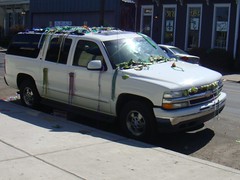Fantastic weather. Drove off in the truck. Married to the love of my life, Candice.
Take care, y'all.
Saturday, March 27, 2010
Tuesday, March 23, 2010
Sunday, March 14, 2010
Offshore History - "Offshore Pioneers"
I've been on the hunt for a good history of the offshore industry. So far, I haven't found a really good one.

The Prize is probably, overall, the best history of the oil industry. There are some omissions and minor errors, but from a story-telling standpoint, it can't be beat. It also doesn't really concentrate on offshore.

Oil 101 by Morgan Downey is probably the best from a pure factual and bias standpoint. Morgan Downey was an oil trader on Wall Street who had a very good grasp of the technical aspects of the oil industry. It's very dispassionate in its presentation and it's very, very thorough with a good chapter on Exploration and Production that takes up half the book. The problem with the book is its halfway a reference manual, so it's not much on narrative.
While hunting around I came upon a history of Brown & Root (B&R):
Offshore Pioneers: Brown & Root and the History of Offshore Oil and Gas

It took a little while to find a copy, because it's be out of print for about 10 years. The book was put together by 3 history professors who got funding from Brown and Root, but it's openly disclosed in the forward, so you have a heads up about the bias. It's very pro-B&R, obviously, but the advantage of that is they got access to so many key people. It's not a 100% whitewashing of history, but what I like is even if they would whitewash some of the B&R history, they had no qualms about dumping on the competition.
For example, Shell's Cognac platform was built in '77-'78 by New Orleans-based J. Ray McDermott. It was a HUGE milestone in offshore engineering at the time. It was a fixed structure in over 1,000 feet of water that cost $250 million to build and weighed 59,000 tons.
Well, one of the things that's talked about in the book was that B&R built a two platforms for Union Oil in almost as deep water (~955 feet vs. 1,025 feet for Cognac) that each cost less than $90 million. B&R was better able to calculate the forces and their interactions and could thus shave down the weight of the tower down to 26,000 tons.
In a little jab at Shell, the platforms were named Cervaza and Cervaza Light (Garden Banks Blocks 160 & 158). You see, Cognac is expensive and beer is, well, not... Engineer humor... Hardy har har...
The two best chapters in the book weren't really about B&R at all, though. They were about Project Mohole and Taylor Diving.
Project Mohole was an attempt to use an offshore drilling vessel in 15,000 feet of water to drill through another 25,000 feet of the earth's crust to the Mohorovičić discontinuity, collecting core samples the whole way down, and recover a piece of the Earth's mantle. Keep in mind, when Project Mohole was initiated, the deepest offshore well at that time was in only 200 feet of water. The project required taking existing technology and pushing it forward not just evolutionarily, but by leaps and bounds.
Today's most advanced Polycrystaline Drill Bits are direct descendants of the drill bit developed in the Phase I test. In that test, the drillship stayed in place with dynamic positioning, drilled an initial hole, and (through much trial and error) re-entered the original hole, and captured samples from a subsurface column of basalt. A drill bit studded with thousands of tiny diamonds was necessary to cut through the basalt, which was like drilling through hundreds of feet of steel.
Project Mohole suffered a series of major cost overruns and was always a target of political sniping. Eventually, the project was axed, mostly to pay for the Vietnam War. Imagine what sort of contributions to petroleum engineering, geology, and geophysics might have been made if it wasn't axed to pay for a pointless war...
As it was, prospects like BP's Tiber & Exxon's Blackbeard wouldn't be happening at this time without the jolt that Project Mohole gave to deepwater drilling. While things were a little better back then, private companies HATE spending money on R&D, especially on things where the usefulness-horizon isn't in X-many quarters.
The other chapter I really liked was about Taylor Diving. If it's related to human beings breathing or working under water, it was developed either by the US Navy or Taylor.
The funniest thing is how Taylor Diving got its start. It was started by three guys. Two of them were Navy veterans and the third, Jean Valz, was a veteran of the French Resistance. In 1959, L. E. Minor, the head of engineering for B&R, was out drinking on Bourbon Street and stopped in Lafitte's Blacksmith Shop, one of his favorite watering holes. Moonlighting as a piano player was Jean Valz. The two struck up a conversation and by the end of the year, most of B&R's diving work was subbed out to Taylor. Both companies would later be bought by Halliburton.
Taylor Diving, as time went on, conducted research into underwater welding and saturation diving at their test facility in Belle Chasse, LA. They could simulate dives past 1,000 feet and could play around with air mixtures and welding filler rods and everything, all under close supervision by doctors.
Offshore Pioneers is good at filling in the details and dates for a lot of things I've heard of randomly working in the oil business, but not in a thorough, systematic way. I'm still on the hunt for one all-encompassing offshore history, though.

The Prize is probably, overall, the best history of the oil industry. There are some omissions and minor errors, but from a story-telling standpoint, it can't be beat. It also doesn't really concentrate on offshore.

Oil 101 by Morgan Downey is probably the best from a pure factual and bias standpoint. Morgan Downey was an oil trader on Wall Street who had a very good grasp of the technical aspects of the oil industry. It's very dispassionate in its presentation and it's very, very thorough with a good chapter on Exploration and Production that takes up half the book. The problem with the book is its halfway a reference manual, so it's not much on narrative.
While hunting around I came upon a history of Brown & Root (B&R):
Offshore Pioneers: Brown & Root and the History of Offshore Oil and Gas

It took a little while to find a copy, because it's be out of print for about 10 years. The book was put together by 3 history professors who got funding from Brown and Root, but it's openly disclosed in the forward, so you have a heads up about the bias. It's very pro-B&R, obviously, but the advantage of that is they got access to so many key people. It's not a 100% whitewashing of history, but what I like is even if they would whitewash some of the B&R history, they had no qualms about dumping on the competition.
For example, Shell's Cognac platform was built in '77-'78 by New Orleans-based J. Ray McDermott. It was a HUGE milestone in offshore engineering at the time. It was a fixed structure in over 1,000 feet of water that cost $250 million to build and weighed 59,000 tons.
Well, one of the things that's talked about in the book was that B&R built a two platforms for Union Oil in almost as deep water (~955 feet vs. 1,025 feet for Cognac) that each cost less than $90 million. B&R was better able to calculate the forces and their interactions and could thus shave down the weight of the tower down to 26,000 tons.
In a little jab at Shell, the platforms were named Cervaza and Cervaza Light (Garden Banks Blocks 160 & 158). You see, Cognac is expensive and beer is, well, not... Engineer humor... Hardy har har...
The two best chapters in the book weren't really about B&R at all, though. They were about Project Mohole and Taylor Diving.
Project Mohole was an attempt to use an offshore drilling vessel in 15,000 feet of water to drill through another 25,000 feet of the earth's crust to the Mohorovičić discontinuity, collecting core samples the whole way down, and recover a piece of the Earth's mantle. Keep in mind, when Project Mohole was initiated, the deepest offshore well at that time was in only 200 feet of water. The project required taking existing technology and pushing it forward not just evolutionarily, but by leaps and bounds.
Today's most advanced Polycrystaline Drill Bits are direct descendants of the drill bit developed in the Phase I test. In that test, the drillship stayed in place with dynamic positioning, drilled an initial hole, and (through much trial and error) re-entered the original hole, and captured samples from a subsurface column of basalt. A drill bit studded with thousands of tiny diamonds was necessary to cut through the basalt, which was like drilling through hundreds of feet of steel.
Project Mohole suffered a series of major cost overruns and was always a target of political sniping. Eventually, the project was axed, mostly to pay for the Vietnam War. Imagine what sort of contributions to petroleum engineering, geology, and geophysics might have been made if it wasn't axed to pay for a pointless war...
As it was, prospects like BP's Tiber & Exxon's Blackbeard wouldn't be happening at this time without the jolt that Project Mohole gave to deepwater drilling. While things were a little better back then, private companies HATE spending money on R&D, especially on things where the usefulness-horizon isn't in X-many quarters.
The other chapter I really liked was about Taylor Diving. If it's related to human beings breathing or working under water, it was developed either by the US Navy or Taylor.
The funniest thing is how Taylor Diving got its start. It was started by three guys. Two of them were Navy veterans and the third, Jean Valz, was a veteran of the French Resistance. In 1959, L. E. Minor, the head of engineering for B&R, was out drinking on Bourbon Street and stopped in Lafitte's Blacksmith Shop, one of his favorite watering holes. Moonlighting as a piano player was Jean Valz. The two struck up a conversation and by the end of the year, most of B&R's diving work was subbed out to Taylor. Both companies would later be bought by Halliburton.
Taylor Diving, as time went on, conducted research into underwater welding and saturation diving at their test facility in Belle Chasse, LA. They could simulate dives past 1,000 feet and could play around with air mixtures and welding filler rods and everything, all under close supervision by doctors.
Offshore Pioneers is good at filling in the details and dates for a lot of things I've heard of randomly working in the oil business, but not in a thorough, systematic way. I'm still on the hunt for one all-encompassing offshore history, though.
Don't park on the parade route
Remember, it's for your own good.
Man, it's going to take forever to clean up this car. Don't forget about the dents in the hood from people standing on the vehicle. The parade goers have even tied strings of beads to the roof rack.
Man, it's going to take forever to clean up this car. Don't forget about the dents in the hood from people standing on the vehicle. The parade goers have even tied strings of beads to the roof rack.
Sunday, March 7, 2010
Project Truck Update: Getting all dolled up Edition
When we last left off, Patches still had a blown exhaust gasket. Well, we're finally past Saints in the Superbowl, Mardi Gras, bad weather, and all, so today it was back to work.
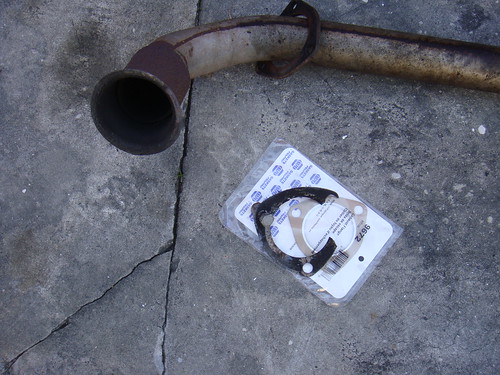
It took a little while to get everything pulled together. The first trip of NAPA left me with the wrong sized gasket. When it's possible to get the wrong size gasket, you will and then you'll find NAPA is closed. That was me a couple of weeks ago. Today, though, I had the right gasket.
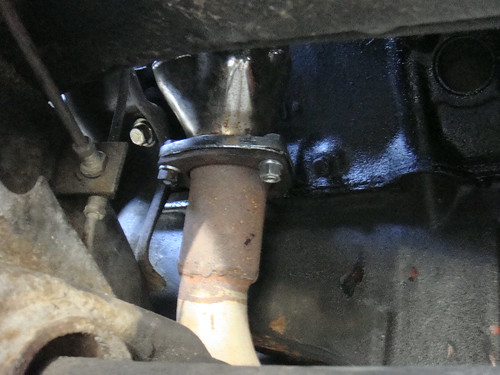
Got the whole exhaust attached. Not too many photos of the process. It was a lot of grunting and torquing and yelling and grease and grime and sweat. In other words, fun!
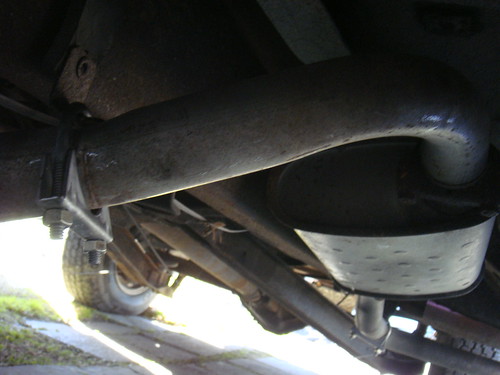
I had some help from Steven and we got everything back in place and replaced all the exhaust U-Bolts.
Patches is now even relatively quiet!
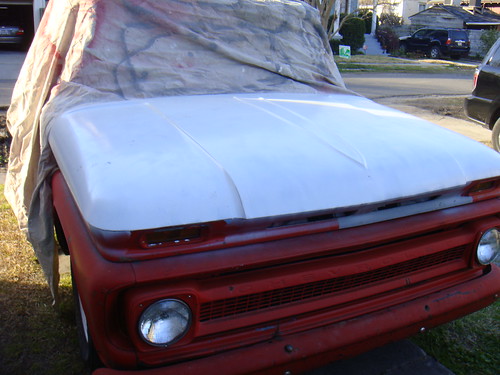
Also gave Patches a nice new coat of paint on the hood.
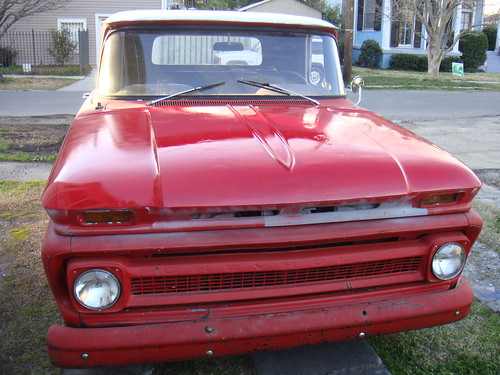
Patches will (weather permitting) make an appearance at the wedding (now less than 3 weeks away). We have to have her looking her best. Candice has been getting ideas on how to dress Patches up...

It took a little while to get everything pulled together. The first trip of NAPA left me with the wrong sized gasket. When it's possible to get the wrong size gasket, you will and then you'll find NAPA is closed. That was me a couple of weeks ago. Today, though, I had the right gasket.

Got the whole exhaust attached. Not too many photos of the process. It was a lot of grunting and torquing and yelling and grease and grime and sweat. In other words, fun!

I had some help from Steven and we got everything back in place and replaced all the exhaust U-Bolts.
Patches is now even relatively quiet!

Also gave Patches a nice new coat of paint on the hood.

Patches will (weather permitting) make an appearance at the wedding (now less than 3 weeks away). We have to have her looking her best. Candice has been getting ideas on how to dress Patches up...
Thursday, March 4, 2010
The eXile
Vanity Fair profiles Matt Taibbi and Mark Ames and their paper "The eXile."
I've been reading the eXile for a while. I'm not really sure how long. I've always been shocked at what they've been able to get away with, but that's not what's kept me coming back. They're so damned accurate. They'll nail things way before anyone else. Mark Ames has "the best best bullshit detector on Earth," finely honed after many years in Russia.
They pull no punches, Democrat or Republican: 20 Reasons Why We're Ashamed to be an American.
Their most offensive series ever was "Whore-R-Stories" where Mark Ames would purchase a prostitute and write up the entire night's event.
They got all this published in Putin's Russia. Eventually they got shut down and The Wall Street Journal (who they constantly lampooned) wrote their obituary.
Go read the Vanity Fair article! Cajun Boy agrees: "Matt Taibbi is a thrower of Coffee and Horse Semen Pies to the Face"
UPDATE- While browsing, I found some Russian footage about the infamous Hungry Duck bar in Moscow:
You can also read the rump of what's left of the eXile at Exiled Online.
I've been reading the eXile for a while. I'm not really sure how long. I've always been shocked at what they've been able to get away with, but that's not what's kept me coming back. They're so damned accurate. They'll nail things way before anyone else. Mark Ames has "the best best bullshit detector on Earth," finely honed after many years in Russia.
They pull no punches, Democrat or Republican: 20 Reasons Why We're Ashamed to be an American.
Their most offensive series ever was "Whore-R-Stories" where Mark Ames would purchase a prostitute and write up the entire night's event.
They got all this published in Putin's Russia. Eventually they got shut down and The Wall Street Journal (who they constantly lampooned) wrote their obituary.
Go read the Vanity Fair article! Cajun Boy agrees: "Matt Taibbi is a thrower of Coffee and Horse Semen Pies to the Face"
UPDATE- While browsing, I found some Russian footage about the infamous Hungry Duck bar in Moscow:
You can also read the rump of what's left of the eXile at Exiled Online.
Subscribe to:
Posts (Atom)

